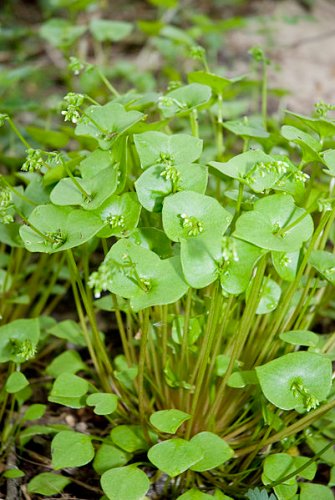Miner's Lettuce (Claytonia perfoliata) Gardening
[an error occurred while processing this directive]
Miner's Lettuce (Claytonia perfoliata syn. Montia perfoliata) is an annual succulent plant in the family Portulacaceae, native to Western North America, from British Columbia to California and Mexico. It is also known as Spring Beauty, Winter Purslane, and Indian Lettuce. Miner's lettuce is usually grown in moist, shady areas in chaparral, woodland, sage scrub, disturbed and waste ground, moist banks and slopes. The genus name Claytonia is named after John Clayton, an 18th century botanist.
Miner's lettuce is a trailing plant, up to 30 cm tall, and branching from the base. There are two types of leaves. Lower leaves are elongated in shaped, and have petioles. Upper leaves, 7 cm in diameter, are cupped and roundish, and sometimes shaped a bit like the letter 'B'. The distinctive feature of the plant is how the flower stem appears to emerge through the upper leaf. The small, white or pink, five-petaled flowers, 2-6 mm long, are in small racemes, 5-40 together, at the center of round, perfoliate leaves, blooming from February through May. The leaves are green and fleshy, and as the days get hotter, they turn red, orange, or yellow as they dry out.
The young leaves, flowers and flower stalks of Miner's lettuce are edible, and can be eaten fresh or cooked. They do well in salads or boiled, with taste like spinach. Older leaves and drought-stressed leaves may be bitter.
Miner's lettuce is high in vitamin C.

Miner's Lettuce (Claytonia perfoliata)
Author: Olivier Pichard (Creative Commons Attribution 3.0 Unported)
|

